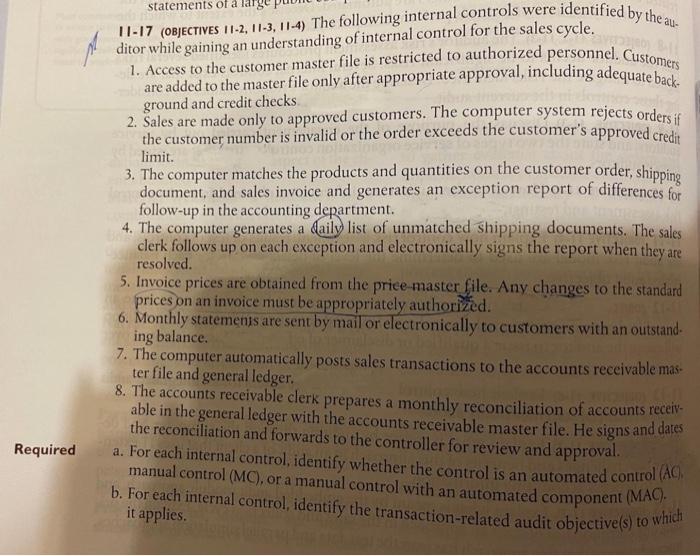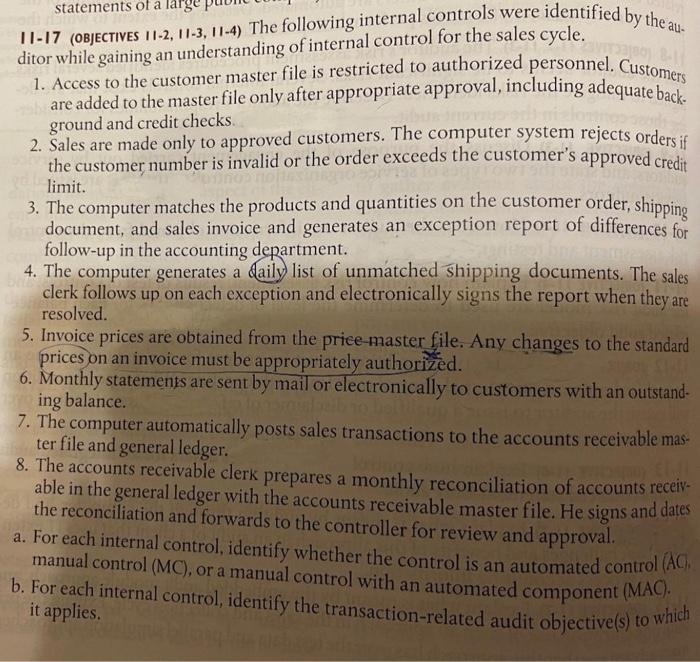statements of a large 11-17 (OBJECTIVES 11-2, 11-3, 11-4) The following internal controls were identified by the au- ditor while gaining an understanding of internal control for the sales cycle. 1. Access to the customer master file is restricted to authorized personnel. Customer are added to the master file only after appropriate approval, including adequate back . 2. Sales are made only to approved customers. The computer system rejects orders if the customer number is invalid or the order exceeds the customer's approved credit limit. 3. The computer matches the products and quantities on the customer order, shipping document, and sales invoice and generates an exception report of differences for follow-up in the accounting department. 4. The computer generates a daily list of unmatched shipping documents. The sales clerk follows up on each exception and electronically signs the report when they are resolved. 5. Invoice prices are obtained from the price master file. Any changes to the standard prices on an invoice must be appropriately authorized. 6. Monthly statements are sent by mail or electronically to customers with an outstand- ing balance. 7. The computer automatically posts sales transactions to the accounts receivable mas- ter file and general ledger. 8. The accounts receivable clerk prepares a monthly reconciliation of accounts receiv- able in the general ledger with the accounts receivable master file. He signs and dates the reconciliation and forwards to the controller for review and approval. a. For each internal control, identify whether the control is an automated control (AC), manual control (MC), or a manual control with an automated component (MAC), b. For each internal control, identify the transaction-related audit objective(s) to which it applies. Required statements of a large 11-17 (OBJECTIVES 11-2, 11-3, 11-4) The following internal controls were identified by the au- ditor while gaining an understanding of internal control for the sales cycle. 1. Access to the customer master file is restricted to authorized personnel. Customers are added to the master file only after appropriate approval, including adequate back ground and credit checks 2. Sales are made only to approved customers. The computer system rejects orders if the customer number is invalid or the order exceeds the customer's approved credit limit. 3. The computer matches the products and quantities on the customer order, shipping document, and sales invoice and generates an exception report of differences for follow-up in the accounting department. 4. The computer generates a daily list of unmatched shipping documents. The sales clerk follows up on each exception and electronically signs the report when they are resolved. 5. Invoice prices are obtained from the price master file. Any changes to the standard prices on an invoice must be appropriately authorized. 6. Monthly statements are sent by mail or electronically to customers with an outstand- ing balance. 7. The computer automatically posts sales transactions to the accounts receivable mas- ter file and general ledger. 8. The accounts receivable clerk prepares a monthly reconciliation of accounts receiv- able in the general ledger with the accounts receivable master file. He signs and dates the reconciliation and forwards to the controller for review and approval. a. For each internal control, identify whether the control is an automated control (AC) manual control (MC), or a manual control with an automated component (MAO). b. For each internal control, identify the transaction-related audit objective(s) to which it applies








